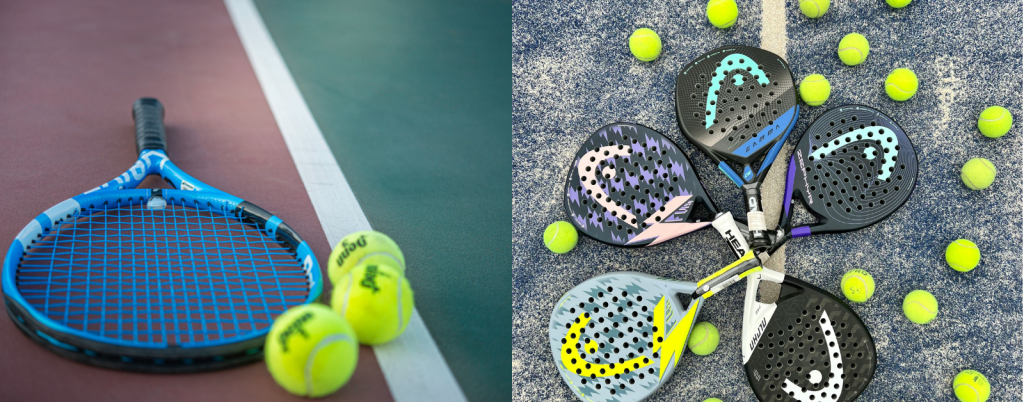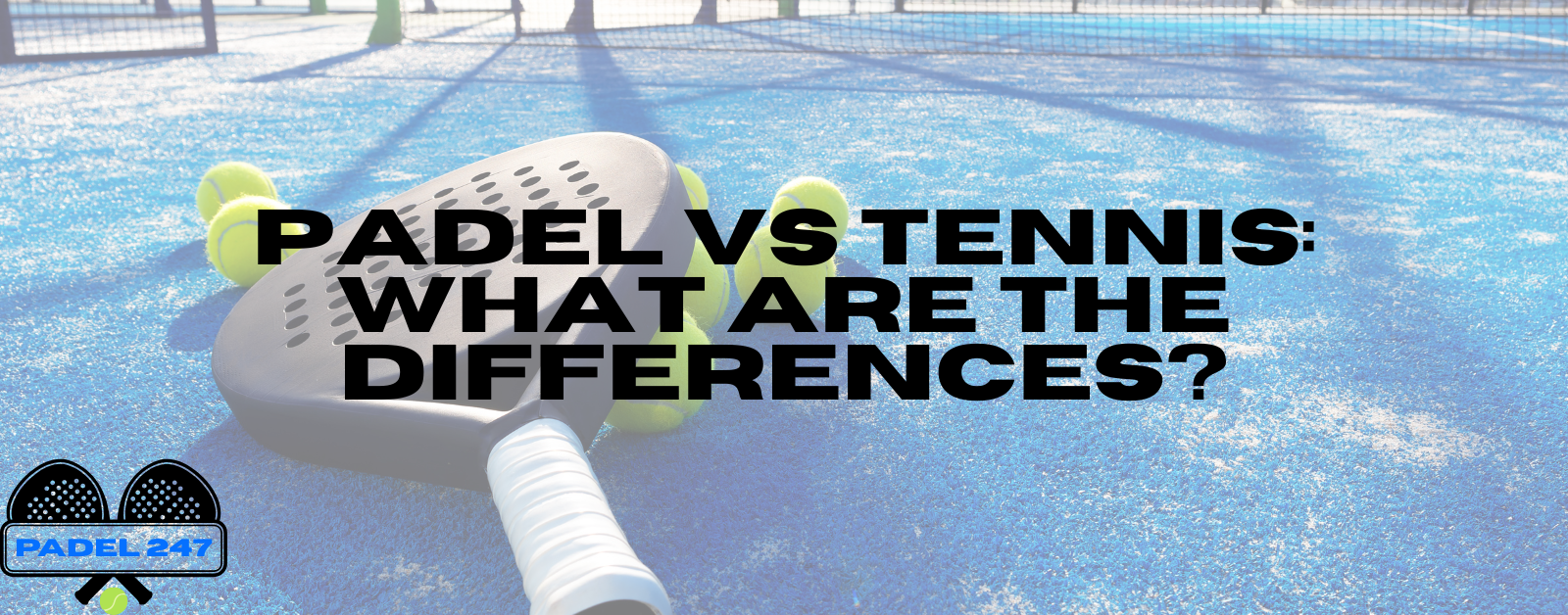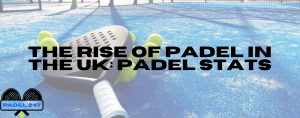Padel and tennis are two racket sports that share similarities in scoring and structure but offer very different experiences. While tennis is one of the most established global sports, padel is newer, more social, and growing rapidly.
Below, we’ll explore the key differences between padel and tennis.
⚡ Quick Overview: Padel vs Tennis
| Padel | Tennis | |
|---|---|---|
| Court | Smaller, enclosed with glass walls | Larger, open, no walls |
| Rackets | Solid, perforated, no strings | Stringed racquet with tension variations |
| Serve | Always underhand | Overhead, powerful |
| Play Style | Fast rallies, walls in play | Longer rallies, baseline power |
| Difficulty | Easier to learn, beginner friendly | Steeper learning curve, more technical |
| Popularity | 30M players worldwide | 106M players worldwide |
In short: padel is fast-paced, doubles-focused, and beginner-friendly, while tennis demands more technique, power, and endurance.
Courts & Equipment
Padel is played on a 20m x 10m enclosed court with glass or mesh walls, which keep rallies going. This is one of the main playing differences between Tennis & Pickleball.
Rackets are solid, perforated, and stringless. Again, this makes it vary from Tennis. Padel balls are similar to tennis but with slightly less pressure.
Tennis is played on a 23.77m x 8.23m singles court (or 10.97m doubles), with no walls. Players use stringed racquets, which can be customised for power or control. Balls are pressurised and bounce higher than Padel balls.

Rules & Scoring
Both sports use the traditional tennis scoring system (15, 30, 40, game; sets; tie-breaks). There are some differences to playing rules however:
- Padel: The ball can bounce once before being returned and walls are in play after the first bounce. Serves are always underhand.
- Tennis: Serves are overhead and typically powerful. Walls are not in play. Tennis allows more variety in spin and pace, which can make rallies more technical.
Technique & Play Style
Padel requires quick reflexes, anticipation, and smart shot placement. The walls add a squash-like dynamic. It’s less about raw power and more about consistency and angles.
Tennis eelies heavily on technique, athleticism, and power. A strong serve, forehand, or backhand can dominate rallies.
Footwork and stamina play a huge role, especially in longer matches.
Cost of Playing
Padel: Court hire is usually cheaper per person because doubles is standard. However, Padel courts are less widely available, so access may be limited. Rackets tend to cost less than tennis racquets.
Tennis: Costs vary widely. Court hire can be inexpensive at public parks but more expensive at clubs. Racquets, restringing, and lessons can add up, making Tennis potentially more costly long-term. There is a wider market for Tennis, meaning there are more options to get second hand gear and equipment, making it potentially cheaper.
Padel vs Tennis Popularity Worldwide
It’s no surprise that Tennis is more popular, but Padel is growing quickly in both the recreational and professional space.
Padel has around 30 million people play globally, with Spain leading at 5.5 million players, followed by Italy, Argentina, and Mexico. There are an estimated 43,000–63,000 courts worldwide.
Tennis is atruly global sport, with around 106 million players worldwide. Tennis has a century-long history of professional tournaments, including the Grand Slams, which attract millions of viewers.
Padel vs Tennis Popularity in UK
Padel Popularity In The UK
Padel is growing rapidly in the UK. Over 400,000 adults and juniors played at least once in 2024, and 51,000 played twice a month. There are now 893 courts across 300 venues, with 43% adult awareness and around 8 million people interested in trying the sport.
Tennis Popularity In The UK
Still dominant in the UK, with around 2.6 million adults playing monthly in 2024, up from 1.4 million in 2019. Wimbledon remains one of the world’s most iconic sporting events, boosting national interest each summer.
Noise Levels For Each Sport
Padel is quieter than Pickleball but more enclosed than Tennis. The sound of the ball hitting walls is distinctive but not overly disruptive.
Tennis can be louder, especially at professional levels where players generate more power. Recreationally, tennis noise is mostly the thud of the ball on racquets and courts.
Which Sport Is Best For Beginners
Padel is easier for beginners, with a smaller court, underhand serve, and walls that keep the rally alive make it accessible to all ages. This is one of the main reasons why Padel has grown so significantly over the past few years.
Tennis has a steeper learning curve. Serving overhead, controlling a stringed racquet, and covering a larger court can take longer to master and are more physical than Padel.
Conclusion & Summary
| Aspect | Padel | Tennis |
|---|---|---|
| Court Size | 20m x 10m, enclosed with glass walls | 23.77m x 8.23m (singles), open with no walls |
| Rackets | Solid, perforated, no strings | Stringed racquet |
| Serve | Always underhand | Overhead, powerful |
| Technique | Placement, angles, quick reflexes | Power, spin, stamina, footwork |
| Cost | Cheaper per person, fewer courts available | Varies: public courts cheap, clubs & gear can be expensive |
| Popularity (Global) | 30M players worldwide | 106M players worldwide |
| Popularity (UK) | 400K tried, 51K regular players | 2.6M monthly players |
| Beginner Friendly | Easy to pick up | Steeper learning curve |
| Noise | Softer, walls create extra sound | Louder at higher levels, especially with powerful serves |



